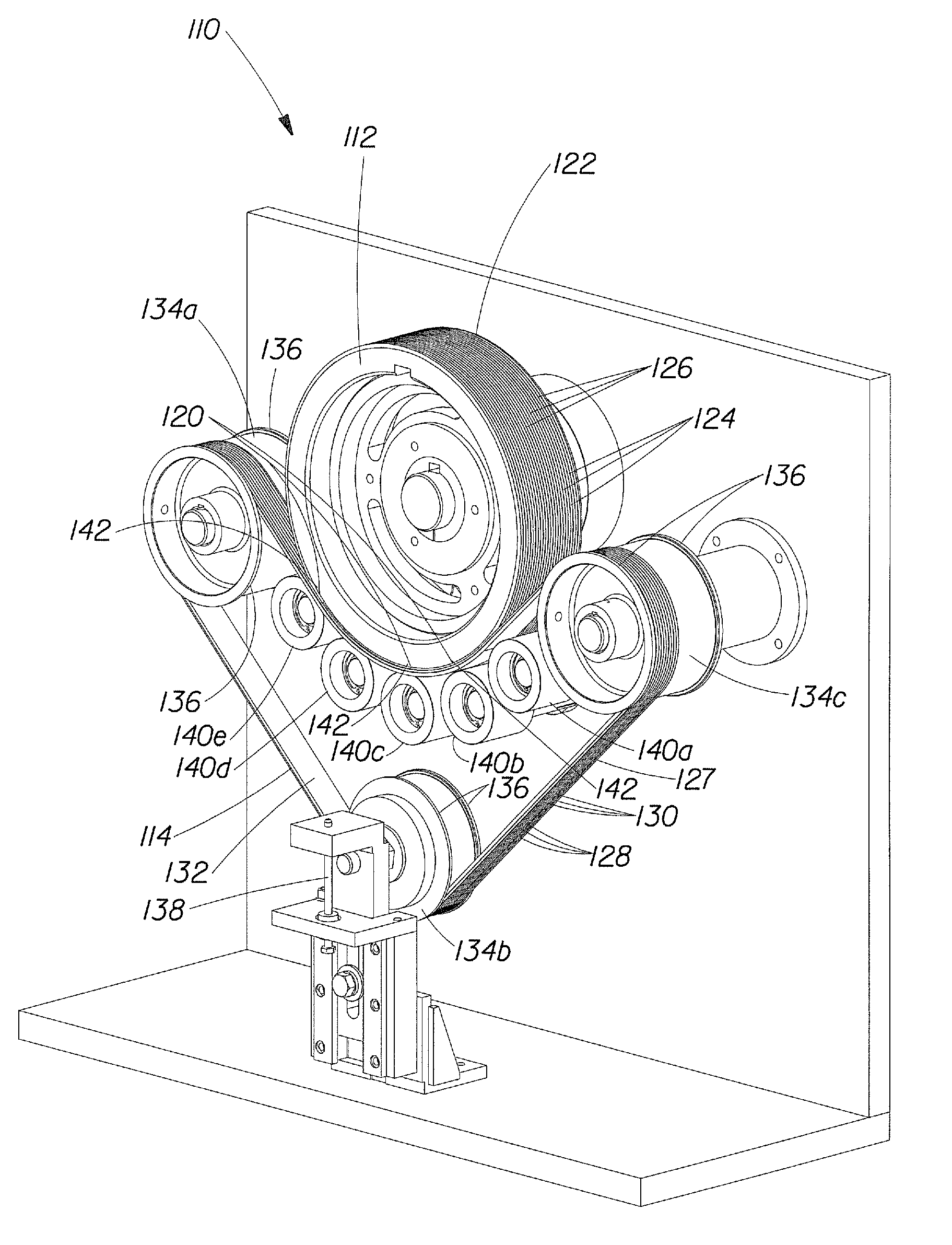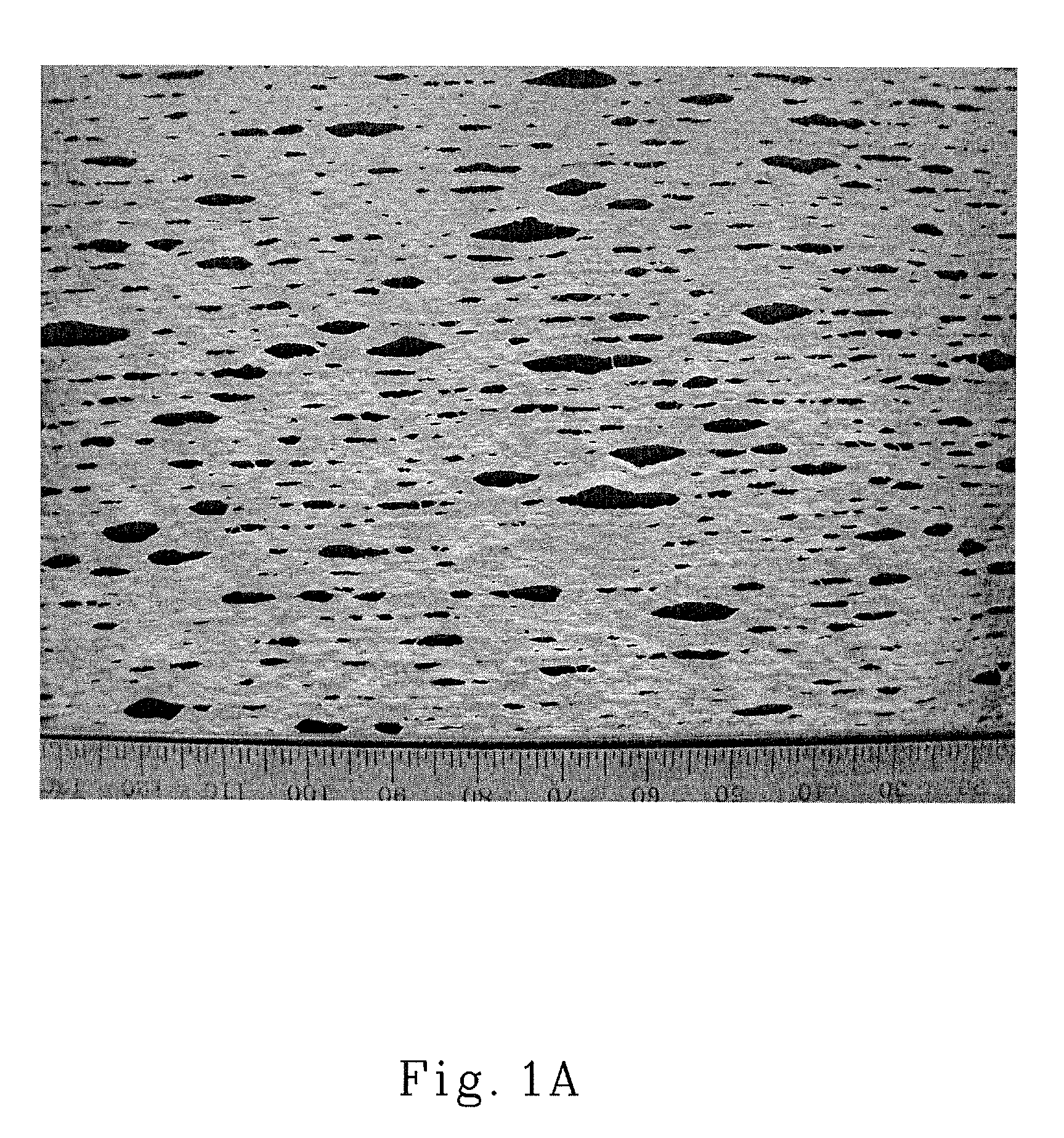[0094]An
advantage of the present invention is that the
path length of the deformation zone can be easily adjusted to be several times greater in length than processes of the prior art. The depth of engagement of the intermeshing teeth and grooves can be set to accommodate web speed, which is the speed the web flows in the
machine direction during
processing. Specifically, it is often desirable to increase the
path length of the deformation zone with increasing line speed. This is done so that the incremental stretching of the web is performed over a longer distance, and hence over a longer period of time, in
spite of the increased web speed. The action of increasing the deformation zone
path length for increasing web speeds can be used to offset the deleterious effects of high speed activation noted in the prior art, such as in aforementioned U.S. Pat. No. 5,143,679 issued to Weber et al. Such prior art ring rolling, accomplished with intermeshing cylindrical rolls, provides a deformation zone(s) having only a fixed path length, fully determined only by the size of the rolls and the required degree of engagement.
[0095]Table I demonstrates how the ring roll
diameter increases significantly for deformation path lengths exceeding 1.0 inches (0.025 meters) in length. For instance, providing a deformation zone path length of 2.0 inches (0.051 meters) would require a ring roll
diameter of about 96 inches (2.44 meters). A deformation path length of 39 inches (1 meter) would require a set of ring rolls of the prior art approaching 1 kilometer in
diameter. Therefore, it can be seen that larger deformation path lengths, while often being desirable to reduce the deleterious effects of higher web speeds, would require use of impractical ring roll sizes. The Table also shows the estimated
machine direction length (MD Length) of the dual activation belt (belt / belt) and single activation roll and activation belt (belt / Roll) apparatus for each corresponding deformation zone path length.TABLE IRange ofCorrespondingDeformationRing RollEstimatedEstimatedZone PathDiameter @Belt / BeltBelt / RollLength0.080″ DOEMD Length*MD Length*(m / in)(m / in)(m / in)(m / in)0.012 / 0.48 0.144 / 5.70.402 / 15.80.395 / 15.60.025 / 0.990.610 / 240.415 / 16.30.401 / 15.80.050 / 2.0 2.44 / 960.440 / 17.30.411 / 16.20.100 / 3.9 9.91 / 3900.490 / 19.30.432 / 17.00.290 / 11.5 82.5 / 32500.680 / 26.80.513 / 20.21.00 / 39 991 / 39000 1.39 / 54.70.815 / 32.1 3.00 / 118— 3.39 / 133 1.66 / 65.4 6.00 / 236— 6.39 / 252 2.94 / 116*MD Length is defined as the minimum space in the
machine direction required for the apparatus.Assumptions:1. Belt / Belt MD length = the deformation zone path length plus 0.39 m for accompanying rollers.2. Belt / Roll MD length = the roll diameter plus 0.39 m for the accompanying back-up rollers.3. Maximum Belt / Roll deformation zone path length = 0.75 * roll circumference (i.e. 270 degree of wrap)
[0096]The beneficial effects of increased deformation zone path length produced via the methods and apparatus of the present invention can be further described in the graphs shown in FIG. 10A and FIG. 10B. Assuming a web speed of about 500 ft / min (2.54 meters per second), a belt
pitch of 0.060 inches (1.52 mm) and a depth of engagement of 0.079 inches (2.0 mm), the graph in FIG. 10A shows the depth of engagement vs. the time of engagement comparing a ring roll
system of the prior art to apparatus of the present invention. The plot illustrates how the path length of the deformation zone for the apparatus of the present invention can be sized and arranged to provide a gradual linear increase in depth of engagement compared to a rapid non linear increase associated with the shorter deformation zone path length of ring rolls. The resulting effect of these differing path lengths is shown in the graph of FIG. 10B, in which the corresponding rate of activation, or rate of engagement, is plotted vs. depth of engagement. The graph demonstrates how ring roll processes of the prior art induce very high rates of strain in the material compared to the very low (and in this case)
constant rate of strain applied by methods and processes of the present invention. This significant decrease in the rate of engagement results in a correspondingly reduced rate of deformation to the web, which effectively minimizes or eliminates the aforementioned deleterious effects that
high activation rates have on many web materials.
[0097]Another means for deforming a web which can be performed using the activation members of the present invention is a process commonly referred to as a “SELF” or “SELF'ing” process, in which SELF stands for Structural Elastic Like Film. While the process was originally developed for deforming
polymer film to have beneficial structural characteristics, it has been found that the SELF'ing process can be used to produce beneficial structures in nonwoven webs.
[0098]Referring to FIG. 11, there is shown a configuration of activation members for use in a SELF process that can be employed to expand portions of a nonwoven web in the web thickness dimension, by expanding portions of the web out of the X-Y plane in the Z-direction. As shown in FIG. 11, one activation member 64 includes a plurality of longitudinally-extending, laterally-spaced teeth 52 and grooves 54. Activation member 62 includes a plurality of longitudinally extending, laterally-spaced teeth 68 wherein portions of the teeth 68 of activation member 62 have been removed to form notches 66 that define a plurality of spaced teeth 68. As shown in FIG. 11, notches 66 on respective transversely adjacent teeth 68 can be aligned laterally to define a plurality of spaced groups of notched regions about the surface of the activation member 62. The respective laterally-extending groups of notched regions each extend parallel to the cross machine direction CD of the activation member 62. Teeth 68 can have a tooth height corresponding to tooth height TH, and a tooth
pitch corresponding to the tooth
pitch P as previously described in reference to FIG. 8.
[0099]As a web passes through a deformation zone formed by activation members in a SELF process, the teeth 68 of activation member 62 press a portion of the web
out of plane to cause permanent, localized Z-direction deformation of the web. But the portion of the web that passes between the notched regions 66 of activation member 62 and the teeth 68 of activation member 62 will be substantially unformed in the Z-direction, i.e., the nonwoven web will not be deformed or stretched in that area to the same degree as that of the toothed regions, and can remain substantially planar, while the portions of the web passing between toothed regions of activation member 62 and the teeth 52 of activation member 64 can be deformed or stretched beyond the elastic limit of the nonwoven, resulting in a plurality of deformed, raised, rib-like elements.
 Login to View More
Login to View More 


